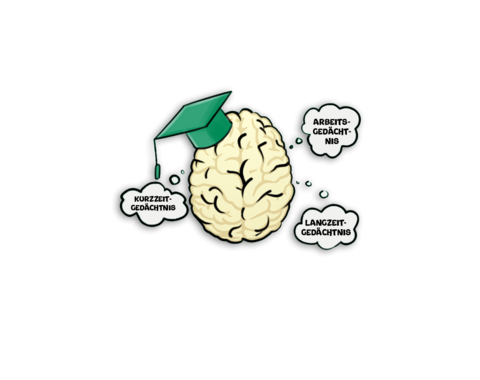Tips from our pros
Our Internal link opens in the same window:Center for Teaching and Learning (ZLL) accompanies our students on their journey at our university, from preparing to study, to taking exams. For example, the ZLL organises regular workshops on topics such as time management, learning methods, etc.
The ZLL also supports lecturers in the development, implementation and further development of contemporary and innovative teaching models.
So that students can also benefit from the broad knowledge of the ZLL, our experts provide you with useful tips on all aspects of learning!
The three-storage model of memory
The "magic" number 7 not only plays a role in fairy tales, but also in learning!
Throughout the day, we are confronted with an endless number of sensory impressions, which our ultra-short-term memory fortunately only stores for an "ultra" short time. That's why we immediately forget the unimportant information (for example, what colour the professor's sweater was).
The more important information is stored in our working memory. But even this is limited, namely to around 7 "information units", also known as "chunks". This is how the American scientist George A. Miller described it in 1956. More recent studies also speak of 3-5 information units (Nowan, 2001). (link to article)
What counts for us is that our working memory is limited!
It is therefore quite normal that we cannot memorise 30 new words in one go or that too much text, too many graphics and animations in PowerPoint presentations confuse us. We have to do a lot to ensure that what we want to learn makes it from our working memory to our long-term memory.
From there, we can recall what we have learned even years later.
What does the three-memory model (ultra-short-term memory, working memory, long-term memory) actually mean for learning?
How do we manage to retain information in our working memory and transfer it to our long-term memory?
How do we manage to retrieve information from long-term memory?
Here come our top tips!
Video tips
- Memory - How does it work? (Biology - simpleclub) https://www.youtube.com/watch?v=yOjONXxYWW8
- How should you learn? The most important rule of thumb. hochschuldidaktik-online. External link opens in a new window:https://youtu.be/Q0gQJqhJSiM
Organise and structure the learning material
We should divide and structure the learning material so that our working memory is not overloaded. The "magic number" 7 helps us to do this. With so-called "chunking", i.e. the grouping or bundling of information units or chunks, we are able to process more than 7 individual pieces of information and expand our working memory to 7 information units.
More about this method External link opens in a new window:https://www.brain-effect.com/magazin/dr-karsten-etwas-theorie-fuers-gedaechtnis-tuning
Warm-up for the brain!
Prior knowledge is an important guarantee of success for learning.
Brainstorming methods such as the External link opens in a new window:ABC List can be used to warm up the brain before active learning. This activates and strengthens the links in the knowledge network and new knowledge can be connected to the nerve cells much more easily (Krause & Stark, 2006).
Krause, U.-M., & Star k, R. (2006). Activating prior knowledge. In H.Mandl & H.F. Friedrich (Eds.), Handbook of learning strategies (pp. 38-49). Hogrefe Publishers. (in German)
Learn actively
Don't: Read through PowerPoint slides, scripts, summaries until everything is memorised.
Do:
- Read through PowerPoint slides, scripts, etc.
- Structure and organise the content (e.g. through visualisations, own summaries)
- Actively recall content.
Examples:- Test yourself with an index card system.
- If necessary, use existing quiz questions or invent your own quiz questions.
- Present the content to yourself out loud in front of a mirror or have someone else quiz you.
Further reading: Metzig & Schuster, 2020, p. 15f
Learn in context
How is what is to be learned tested? If it is an oral exam, it helps to ask a friend to simulate it with you.
Is it a written exam? Make up exam questions (e.g. with the help of ChatGPT) Simulate the exam by using only the permitted aids and answering the questions on time. If necessary, sit in an empty lecture hall. Benefit from the “principle of encoding specificity” (Myers & DeWall, 2023, p.375; Hasselhorn & Gold, 2022, p. 58).
Literature
- Bensberg & Messer (2014). Survivalguide Bachelor. Dein Erfolgscoach fürs ganze Studium - Nie mehr Leistungsdruck, Stress & Prüfungsangst - Bestnoten mit Lerntechniken, Prüfungstipps!. Berlin, Heidelberg
- Krause, U.-M., & Stark, R. (2006). Vorwissen aktivieren. In H.Mandl & H.F. Friedrich (Hrsg), Handbuch Lernstrategien (S. 38-49). Hogrefe Verlag.
- Metzig, W. & Schuster, M. (2020). Lernen zu lernen: Lernstrategien wirkungsvoll einsetzen. Springer
- Miller, G. A. (1956). The magical number seven, plus or minus two: Some limits on our capacity for
processing information. Psychological Review, 63, 81−97. - Hasselhorn, M., & Gold, A. (2022). Pädagogische Psychologie: Erfolgreiches Lernen und Lehren (5., überarbeitete Auflage). Verlag W. Kohlhammer.
- Myers, D. G., & DeWall, C. N. (2023). Psychologie (4., vollständig überarbeitete Auflage). Springer.
Your contact persons
Are you also active in teaching and would like support and exchange?
Please get in touch with our Learning Services team: Email application is started:learning-services(at)hfu.eu
